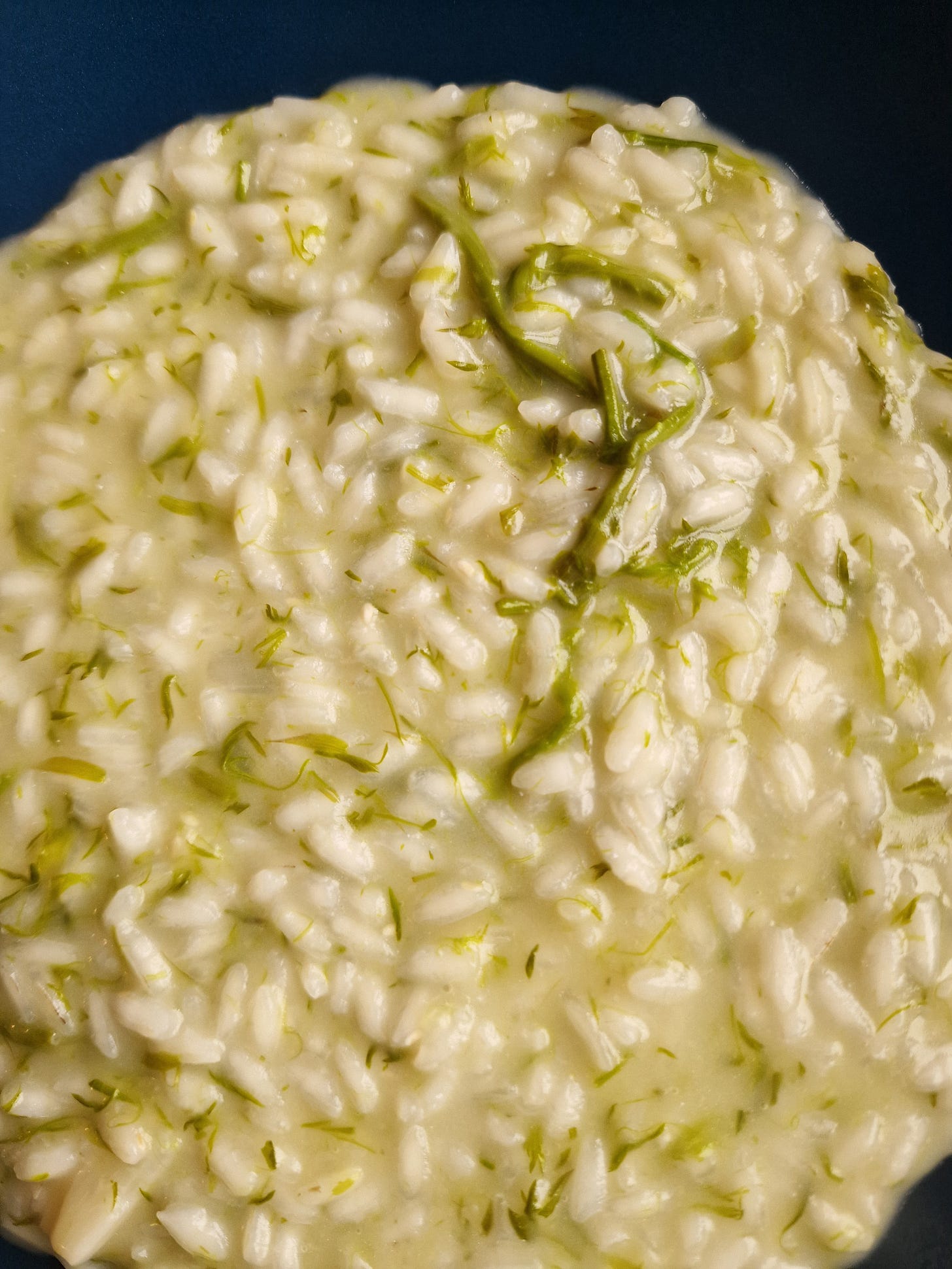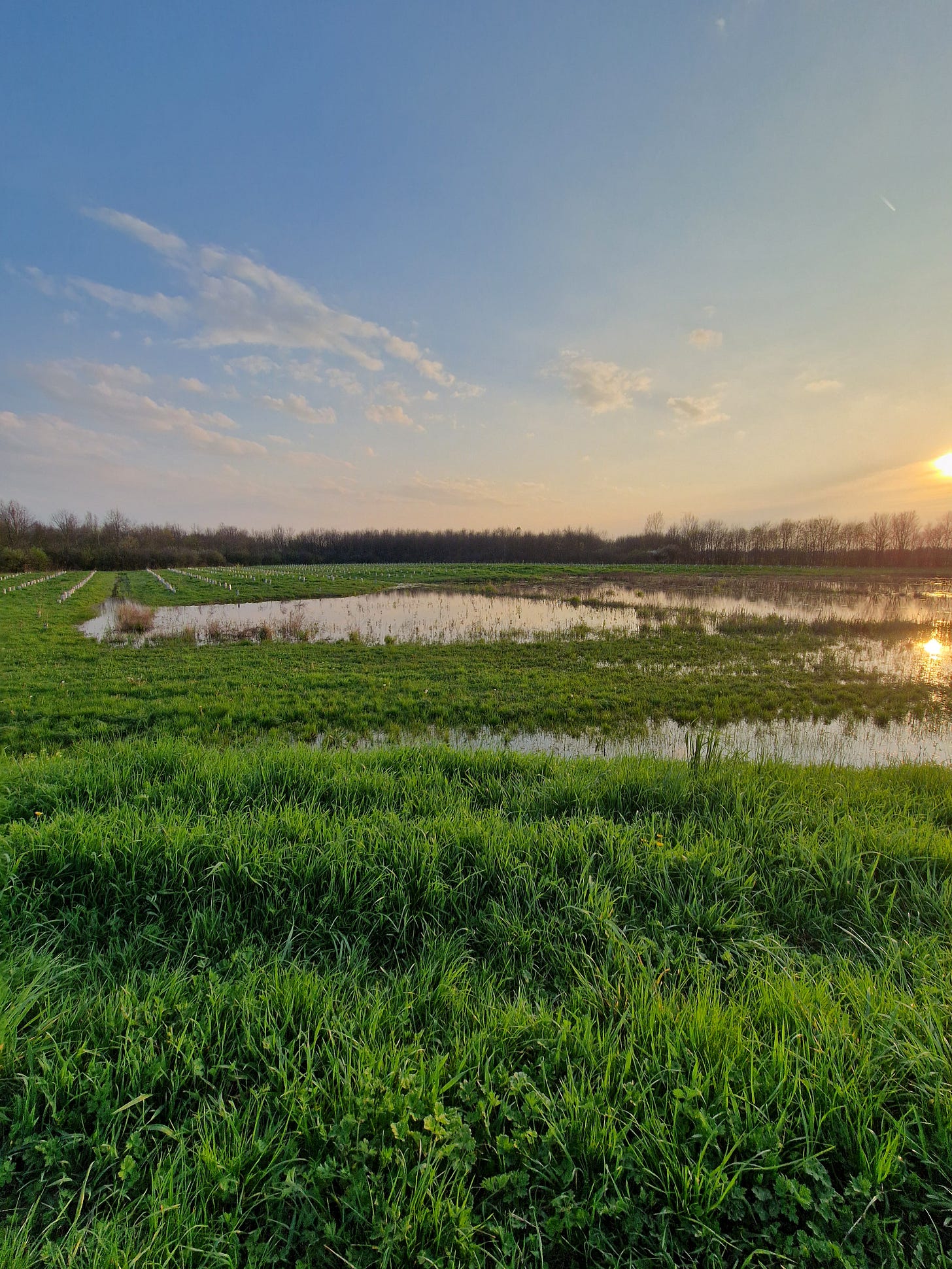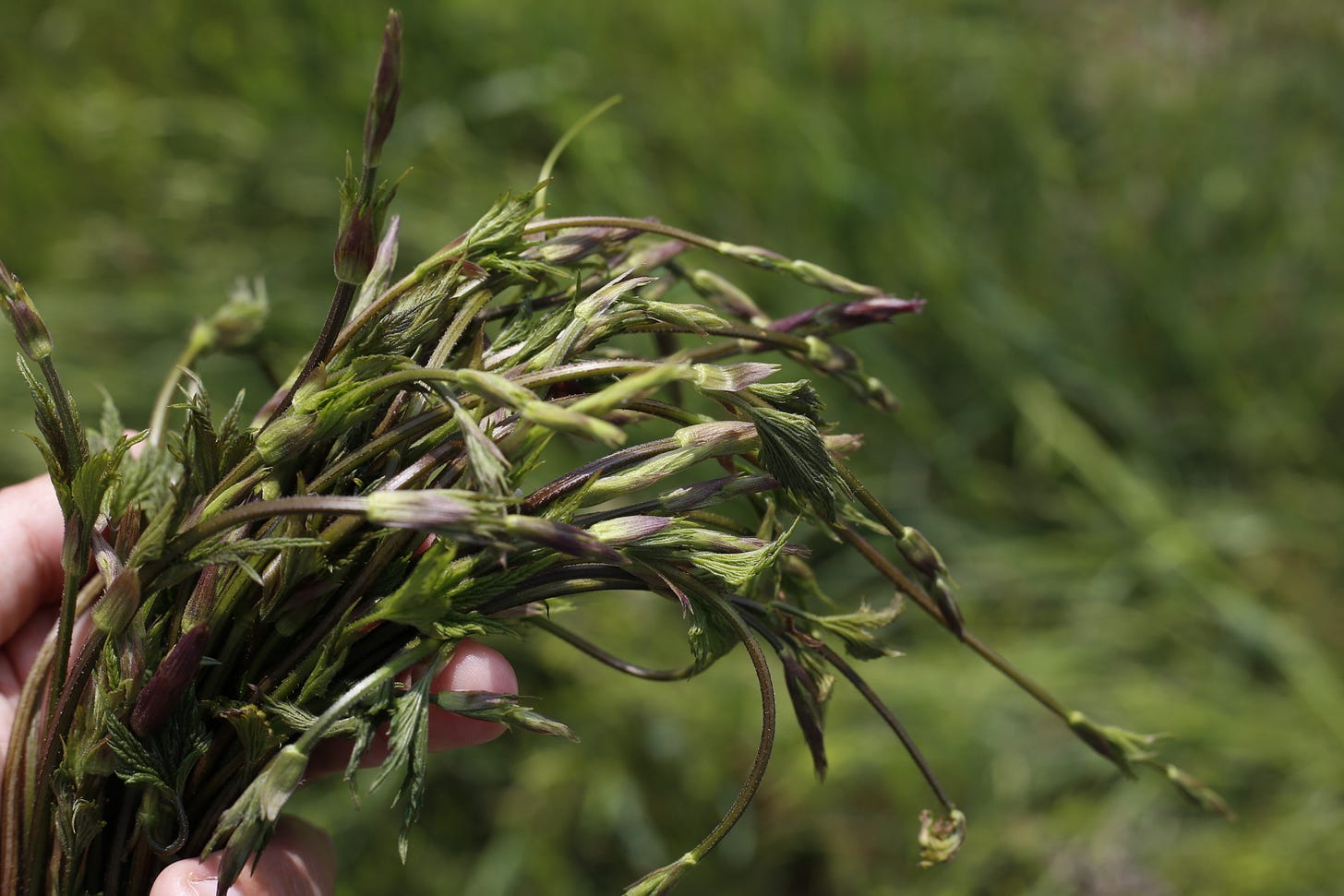Even Elizabeth David Loved It
Every spring, this fleeting wild herb gets Venetians scrambling before the season's gone.
Hi, you're reading Dash of Prosecco, a newsletter about good food, slow travel, and life on the mainland of Venice. April's free post is all about wild hop, a foraged green cherished by locals and… Elizabeth David. Thank you for reading!
Like most of Veneto's population, we forage wild hop shoots ourselves.
When the time comes, between late March and early May, we put on old sneakers and head to the green strip of moist coastal countryside that stretches into Venice’s lagoon.
After months of winter captivity, this is a welcome change and a much awaited occasion for bonding with our local environment, if only for half a day. A special moment of the year we look forward to with trepidation.
The new shoots—wild hop is the ancestor of regular hop, used for brewing—are fully edible and not difficult to spot at all, once you know what they look like: thin hollow stems that pop up from the meadowy carpet, sporting an elongated, flowery head, an occasional purplish tint, and dark leaves similar to hemp (they're related).

In Italian it’called “luppolo selvatico” (literally wild hop). But in the Veneto region there’s a specific name for the spring shoots only—the bit that we actually forage and eat: “bruscandoli.”1
The flavour is reminiscent of raw spinach and asparagus, with a salty bitterness that makes them slightly addictive when added to steaming risottos, clear soups, celebratory frittatas2, and spring lasagnas.
Sure, the long, pointy tops can be found at farmers markets; some supermarkets stock them, too. However foraging remains the most popular (and cheap) way to source them while enjoying a spring day out.
Wild hop loves water. It propagates in colonies, climbing the embankments (argini) that line the many rivers and canals of this humid corner of the world. In spite of it growing easily and abundantly throughout the whole region and northern Italy, I find that it thrives here, near the coast and the lagoon.
You know, this area may lack the charm of the rolling hills of Tuscany, or the imperious beauty of the Dolomites. But it has a wild, rough soul to it that many appreciate. Still, the downsides are there: it's super damp, the soil's soft, the coastline mostly fragmented and swampy. Hardly the ideal place to accommodate modern lifestyle. I’ve always thought it would remain unchanged forever: forgotten, ignored even, exempt from the invasive use of concrete we Italians seem to like so much.
Perhaps I was wrong.
Earlier this month, around the time of our first foraging expedition of the year, a local newspaper informed us that major bulldozing works had just been green-lighted near our usual spot.
Two huge development projects are in the pipeline: a new railway to connect Marco Polo Airport to Venice to assist with tourism flows3, and a large soccer stadium compound. Because of their likely irreversible impact on the local environment, among other controversial aspects, they have been strongly criticized. To no avail.

Bruscandoli are best eaten tender, right after picking. They wilt in a matter of hours.
Once our bunch looks fat enough, we stop plucking and race home for lunch. As we drive, we imagine our baby girl learning to recognize the new shoots, asking questions, acting silly in the meadows.
Will our foraging spot still be there for her in 10 years from now? What it’s going to look like? And feel like? These are the kind of questions we discuss home, our freshly caught treasure sitting on my lap.
In fifteen minutes, we’re climbing the stairs to our apartment; the chatting stops, the cooking begins. I rinse the bunch gently, immersing it in a bowl of cool water with a pinch of bicarb. Then it’s time for some rough chopping. I tip the tops, stems and baby leaves into a shallow frying pan, where tiny grains of rice are heating and sizzling. Today we’re making bruscandoli risotto: light, soft, and gently verdant.
We move quickly because we’re hungry after a whole morning spent outdoors. We eat even more quickly because risotto tastes better when piping hot, no matter the season or the ingredients.
Some things may come and go, others are simply meant to never change.
Spring Frenzy
The arrival of bruscandoli kicks off a spring frenzy for fresh, green delicacies:
Edible herbs, such as carletti (maidenstears) and agretti (monk's beard) brighten the market stalls alongside wild hop. They are some of the much loved foraged foods of the season.
Green and white asparagus, the latter sourced from the town of Bassano del Grappa, are a must and cannot be imagined without some accompanying soft boiled eggs, still warm after deshelling. Like two peas in a pod.
And let’s not forget the highlight of the lagoon's produce: castraúre. Tiny artichoke florets so soft and buttery you can (and should) eat them raw, sliced thin, simply dressed with lemon juice and olive oil.
This is a time of exciting abundance, yet so fleeting; gone as soon as the first heat of May penetrates the fields. We scramble to secure a bunch of this, a kilo of that, before enduring another year without the herbal lymph of the sweetest, quickest spring.
In the video above: carletti, bruscandoli, baby artichokes from Tuscany, green and white asparagus, monk’s beard, wild fennel (?), edible nasturtium flowers and other spring delicacies.
A Love of Fleeting Pleasures
In her beautiful essay, titled “Bruscandoli”, iconic food writer Elizabeth David tells her readers how she first came across a “subtle and creamy” hop top risotto while visiting Venice, in the spring of 1969.
Elizabeth’s party, consisting of her sister, brother-in-law and a mysterious fourth guest, were sitting down for luncheon at Locanda Cipriani on the island of Torcello, when they noticed a couple of distinguished Italians relishing a peculiar rice dish.
Ms. David, being the curious glutton that she was, couldn't help but try some. Head over heels she fell for it, declaring: “A most delicate and remarkable risotto it was.”
Alas, wild hop season was already on its last leg, and in the span of a couple of days they’d already vanished from market stalls and restaurant menus, leaving the writer longing for more. More time, more risottos, more bruscandoli.
“Because they were so very much there one day and vanished the next, bruscandoli became a very sharp and poignant memory.”
NOTE TO READER: If you see bruscandoli advertised on a restaurant menu in Venice or the Veneto at this time of year, drop whatever it is you're doing and grab a table. Chances are, that’s not your usual tourist trap.
Spring News, Links & Readings
Elizabeth David’s essay collection, “An Omelette and a Glass of Wine” includes the Bruscandoli piece, and is a must read for any food writing enthusiast.
Locanda Cipriani was and still is a favourite of many notable figures, including Ernest Hemingway (more about him and Venice in this post).
This local restaurant is serving artichoke florets dishes (castraùre). Visit soon while they are in season.
From YouTube: How to Make a Venetian Asparagus Risotto & Four Easy Artichoke Recipes from Venice.
From the archive: “Agretti”, a sensuous spring herb from the lagoon. Criminally underrated in the kitchen, it was once employed to produce soap and… Murano glass (!).
This illustrated book shows many edible herbs that grow on the coast and islands of Venice’s lagoon (Italian). The author, local journalist Caterina Vianello, publishes trustworthy reviews of restaurants in Venice. Here’s a collection of her articles (Italian, you can use Google Translate to translate whole pages to your desired language).
About Me
My name is Sinù Fogarizzu and I’m a vegetarian food & travel writer from the mainland of Venice, Italy. In 2021, I launched Dash of Prosecco, a Substack newsletter about learning to cook and Venetian cuisine, that has now expanded into slow and sustainable travel. With the new “Slow Venice” column I hope to open up a space for dialogue on ways we can all contribute to a healthier tourism model for the floating city.
Browse my archive and recommended newsletters and come find me on Instagram & Twitter.
Bruscandoli go by countless names, as many as the regions of Northern Italy where they are most appreciated. Just don’t call them wild asparagus, will you? They really are not the same despite the resemblance.
One plant, many names:
Veneto: bruscandoli, luppoli
Friuli: urticiòns
Lombardy: luertis
Piedmont: luvertin, lavertin, lovertin, asparagina
Liguria: verdiscio
Emilia Romagna: vartis
A humble frittata with bruscandoli is among the favourite celebratory foods prepared for the the Feast Day of Saint Mark, patron of the city, on April 25th. Another of such dishes, and perhaps way more famous, is “risi e bisi”, a typical spring risotto with fresh peas that is so soft it could be almost considered a soup.
The Venice Marco Polo airport was built on top of a large swath of endangered lagoon ecosystem, causing massive loss and destruction, and leading to increased pollution right on the coast of the lagoon (today a UNESCO World Heritage Site). The Google Maps screenshot below shows the size and prime coastal location of the airport.











I’m longing to taste these foraged hops and the other spring vegetables you mention, Sinù. I’m a bit embarrassed to admit I’ve never made a risotto, but one made with bruscandoli does sound delicious. Here I imagine I would make it with asparagus. The image of your little girl picking and playing with you in the fields made me smile. I hope this beautiful bounty is preserved for all of you.
What a fabulous education on this greenery! I would never have known. There are so many hidden edible plants and hopefully, they remain with us in the wild despite urban growth. Thank you.
https://writerswrites.com/